Human Factors and Workplace: Improving Patient Safety and Care
VerifiedAdded on 2020/03/16
|13
|3524
|72
Report
AI Summary
This report delves into the crucial role of human factors in healthcare, emphasizing their impact on clinical performance and patient safety. It defines human factors as attributes within a healthcare work environment that enhance clinical practices, including teamwork, equipment, and workplace design. The report discusses how these factors influence human behavior, minimizing medical errors and adverse patient outcomes. It highlights the significance of ergonomics and the application of human factors principles for optimizing performance and mitigating risks. The report covers essential components such as user-centered design, task allocation, and environmental considerations. It provides a case study illustrating the integration of human factors, followed by an analysis of organizational factors like culture and leadership, along with communication and teamwork dynamics. At the individual level, situation awareness and decision-making capabilities are examined as critical elements for preventing errors and ensuring patient safety. This report underscores the importance of understanding and implementing human factors to improve healthcare efficiency, safety, and effectiveness.

Running head: HUMAN FACTORS AND WORKPLACE
HUMAN FACTORS AND WORKPLACE
Name of the student:
Name of the university:
Author note:
HUMAN FACTORS AND WORKPLACE
Name of the student:
Name of the university:
Author note:
Paraphrase This Document
Need a fresh take? Get an instant paraphrase of this document with our AI Paraphraser
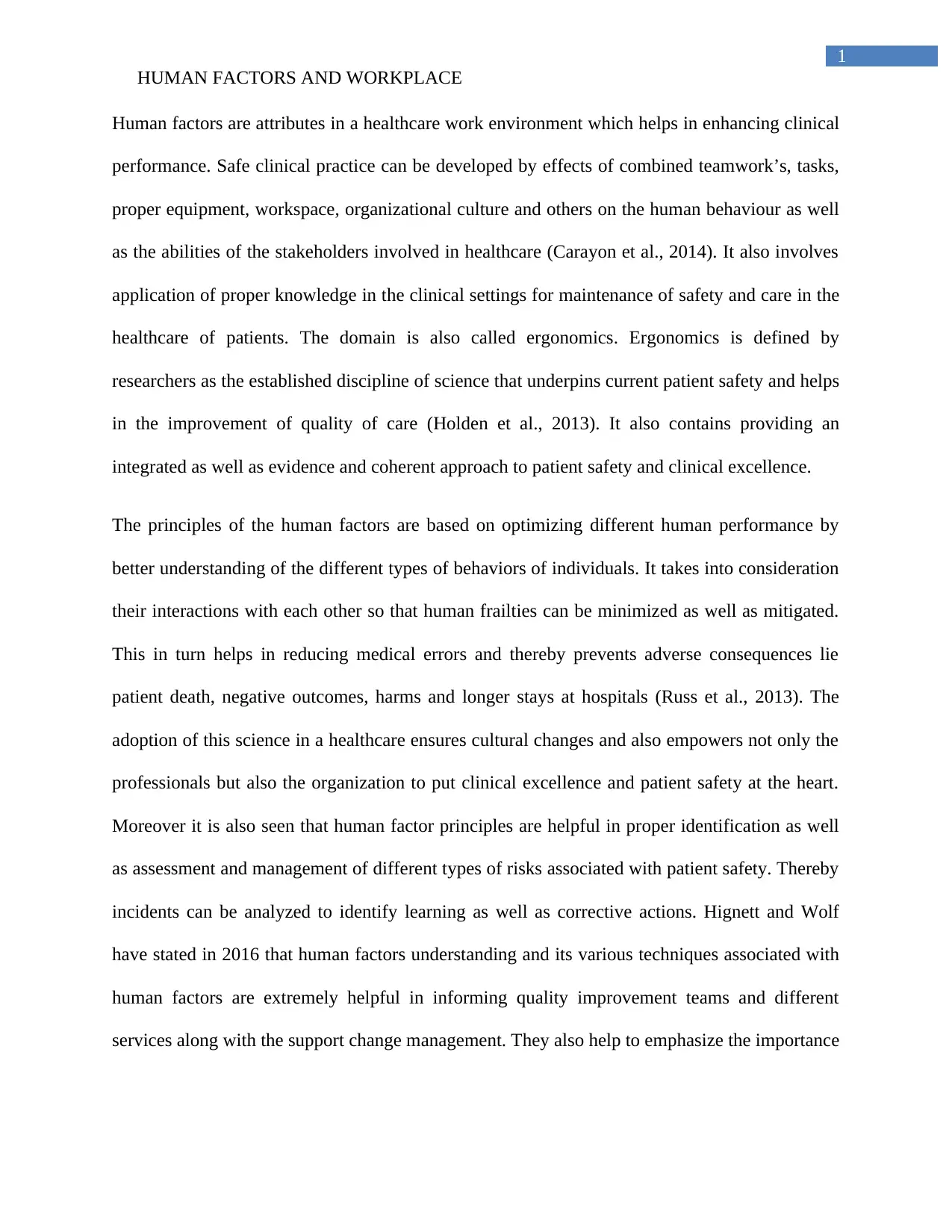
1
HUMAN FACTORS AND WORKPLACE
Human factors are attributes in a healthcare work environment which helps in enhancing clinical
performance. Safe clinical practice can be developed by effects of combined teamwork’s, tasks,
proper equipment, workspace, organizational culture and others on the human behaviour as well
as the abilities of the stakeholders involved in healthcare (Carayon et al., 2014). It also involves
application of proper knowledge in the clinical settings for maintenance of safety and care in the
healthcare of patients. The domain is also called ergonomics. Ergonomics is defined by
researchers as the established discipline of science that underpins current patient safety and helps
in the improvement of quality of care (Holden et al., 2013). It also contains providing an
integrated as well as evidence and coherent approach to patient safety and clinical excellence.
The principles of the human factors are based on optimizing different human performance by
better understanding of the different types of behaviors of individuals. It takes into consideration
their interactions with each other so that human frailties can be minimized as well as mitigated.
This in turn helps in reducing medical errors and thereby prevents adverse consequences lie
patient death, negative outcomes, harms and longer stays at hospitals (Russ et al., 2013). The
adoption of this science in a healthcare ensures cultural changes and also empowers not only the
professionals but also the organization to put clinical excellence and patient safety at the heart.
Moreover it is also seen that human factor principles are helpful in proper identification as well
as assessment and management of different types of risks associated with patient safety. Thereby
incidents can be analyzed to identify learning as well as corrective actions. Hignett and Wolf
have stated in 2016 that human factors understanding and its various techniques associated with
human factors are extremely helpful in informing quality improvement teams and different
services along with the support change management. They also help to emphasize the importance
HUMAN FACTORS AND WORKPLACE
Human factors are attributes in a healthcare work environment which helps in enhancing clinical
performance. Safe clinical practice can be developed by effects of combined teamwork’s, tasks,
proper equipment, workspace, organizational culture and others on the human behaviour as well
as the abilities of the stakeholders involved in healthcare (Carayon et al., 2014). It also involves
application of proper knowledge in the clinical settings for maintenance of safety and care in the
healthcare of patients. The domain is also called ergonomics. Ergonomics is defined by
researchers as the established discipline of science that underpins current patient safety and helps
in the improvement of quality of care (Holden et al., 2013). It also contains providing an
integrated as well as evidence and coherent approach to patient safety and clinical excellence.
The principles of the human factors are based on optimizing different human performance by
better understanding of the different types of behaviors of individuals. It takes into consideration
their interactions with each other so that human frailties can be minimized as well as mitigated.
This in turn helps in reducing medical errors and thereby prevents adverse consequences lie
patient death, negative outcomes, harms and longer stays at hospitals (Russ et al., 2013). The
adoption of this science in a healthcare ensures cultural changes and also empowers not only the
professionals but also the organization to put clinical excellence and patient safety at the heart.
Moreover it is also seen that human factor principles are helpful in proper identification as well
as assessment and management of different types of risks associated with patient safety. Thereby
incidents can be analyzed to identify learning as well as corrective actions. Hignett and Wolf
have stated in 2016 that human factors understanding and its various techniques associated with
human factors are extremely helpful in informing quality improvement teams and different
services along with the support change management. They also help to emphasize the importance
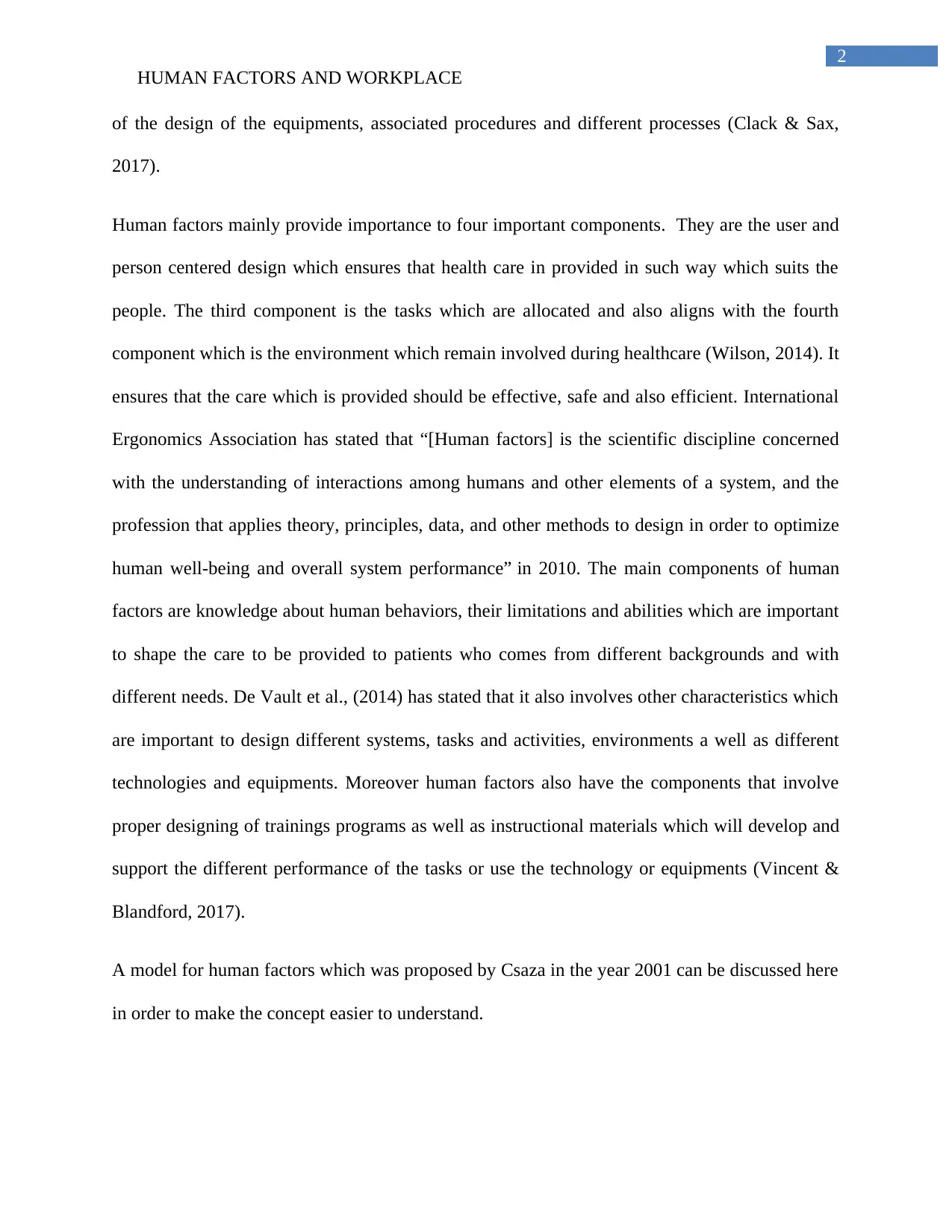
2
HUMAN FACTORS AND WORKPLACE
of the design of the equipments, associated procedures and different processes (Clack & Sax,
2017).
Human factors mainly provide importance to four important components. They are the user and
person centered design which ensures that health care in provided in such way which suits the
people. The third component is the tasks which are allocated and also aligns with the fourth
component which is the environment which remain involved during healthcare (Wilson, 2014). It
ensures that the care which is provided should be effective, safe and also efficient. International
Ergonomics Association has stated that “[Human factors] is the scientific discipline concerned
with the understanding of interactions among humans and other elements of a system, and the
profession that applies theory, principles, data, and other methods to design in order to optimize
human well-being and overall system performance” in 2010. The main components of human
factors are knowledge about human behaviors, their limitations and abilities which are important
to shape the care to be provided to patients who comes from different backgrounds and with
different needs. De Vault et al., (2014) has stated that it also involves other characteristics which
are important to design different systems, tasks and activities, environments a well as different
technologies and equipments. Moreover human factors also have the components that involve
proper designing of trainings programs as well as instructional materials which will develop and
support the different performance of the tasks or use the technology or equipments (Vincent &
Blandford, 2017).
A model for human factors which was proposed by Csaza in the year 2001 can be discussed here
in order to make the concept easier to understand.
HUMAN FACTORS AND WORKPLACE
of the design of the equipments, associated procedures and different processes (Clack & Sax,
2017).
Human factors mainly provide importance to four important components. They are the user and
person centered design which ensures that health care in provided in such way which suits the
people. The third component is the tasks which are allocated and also aligns with the fourth
component which is the environment which remain involved during healthcare (Wilson, 2014). It
ensures that the care which is provided should be effective, safe and also efficient. International
Ergonomics Association has stated that “[Human factors] is the scientific discipline concerned
with the understanding of interactions among humans and other elements of a system, and the
profession that applies theory, principles, data, and other methods to design in order to optimize
human well-being and overall system performance” in 2010. The main components of human
factors are knowledge about human behaviors, their limitations and abilities which are important
to shape the care to be provided to patients who comes from different backgrounds and with
different needs. De Vault et al., (2014) has stated that it also involves other characteristics which
are important to design different systems, tasks and activities, environments a well as different
technologies and equipments. Moreover human factors also have the components that involve
proper designing of trainings programs as well as instructional materials which will develop and
support the different performance of the tasks or use the technology or equipments (Vincent &
Blandford, 2017).
A model for human factors which was proposed by Csaza in the year 2001 can be discussed here
in order to make the concept easier to understand.
⊘ This is a preview!⊘
Do you want full access?
Subscribe today to unlock all pages.

Trusted by 1+ million students worldwide
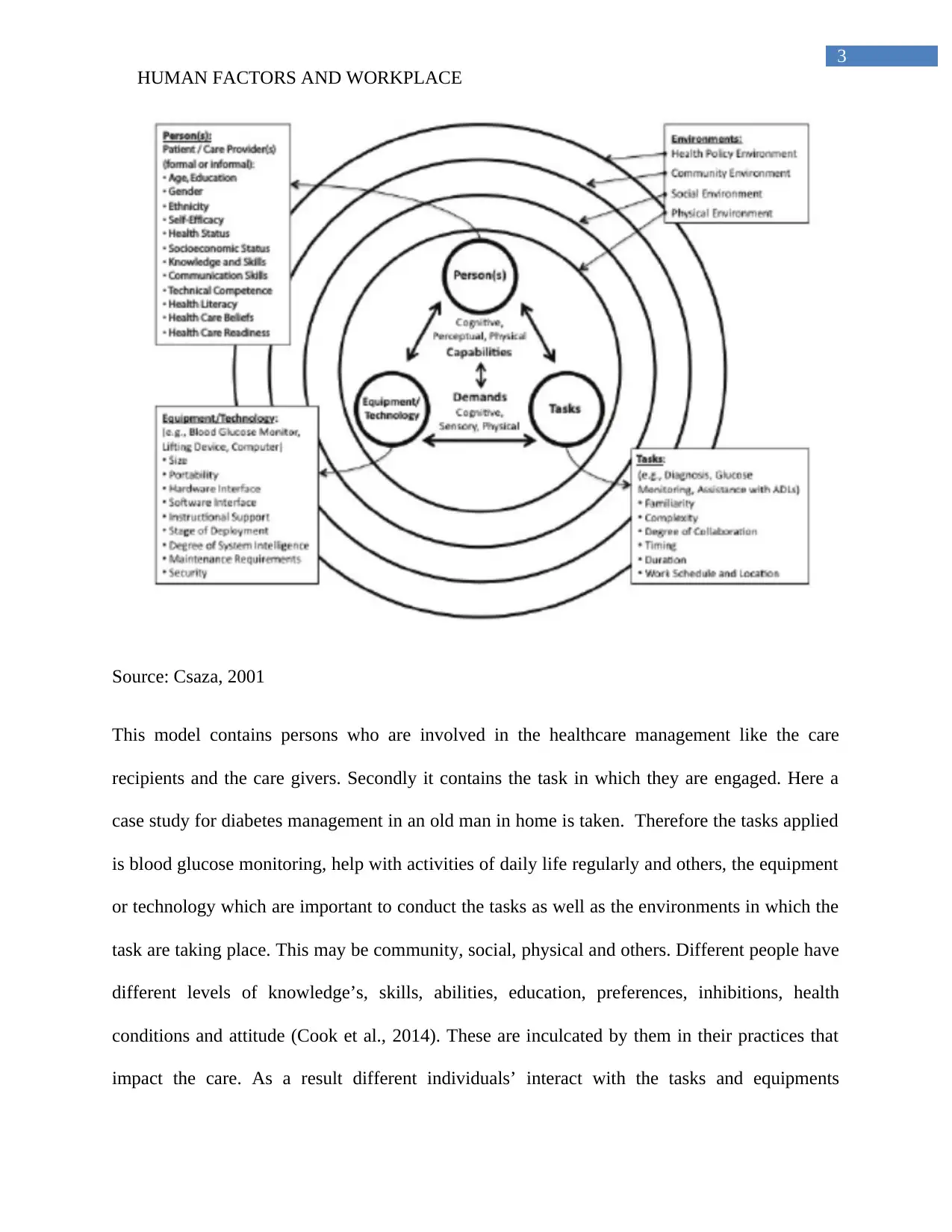
3
HUMAN FACTORS AND WORKPLACE
Source: Csaza, 2001
This model contains persons who are involved in the healthcare management like the care
recipients and the care givers. Secondly it contains the task in which they are engaged. Here a
case study for diabetes management in an old man in home is taken. Therefore the tasks applied
is blood glucose monitoring, help with activities of daily life regularly and others, the equipment
or technology which are important to conduct the tasks as well as the environments in which the
task are taking place. This may be community, social, physical and others. Different people have
different levels of knowledge’s, skills, abilities, education, preferences, inhibitions, health
conditions and attitude (Cook et al., 2014). These are inculcated by them in their practices that
impact the care. As a result different individuals’ interact with the tasks and equipments
HUMAN FACTORS AND WORKPLACE
Source: Csaza, 2001
This model contains persons who are involved in the healthcare management like the care
recipients and the care givers. Secondly it contains the task in which they are engaged. Here a
case study for diabetes management in an old man in home is taken. Therefore the tasks applied
is blood glucose monitoring, help with activities of daily life regularly and others, the equipment
or technology which are important to conduct the tasks as well as the environments in which the
task are taking place. This may be community, social, physical and others. Different people have
different levels of knowledge’s, skills, abilities, education, preferences, inhibitions, health
conditions and attitude (Cook et al., 2014). These are inculcated by them in their practices that
impact the care. As a result different individuals’ interact with the tasks and equipments
Paraphrase This Document
Need a fresh take? Get an instant paraphrase of this document with our AI Paraphraser
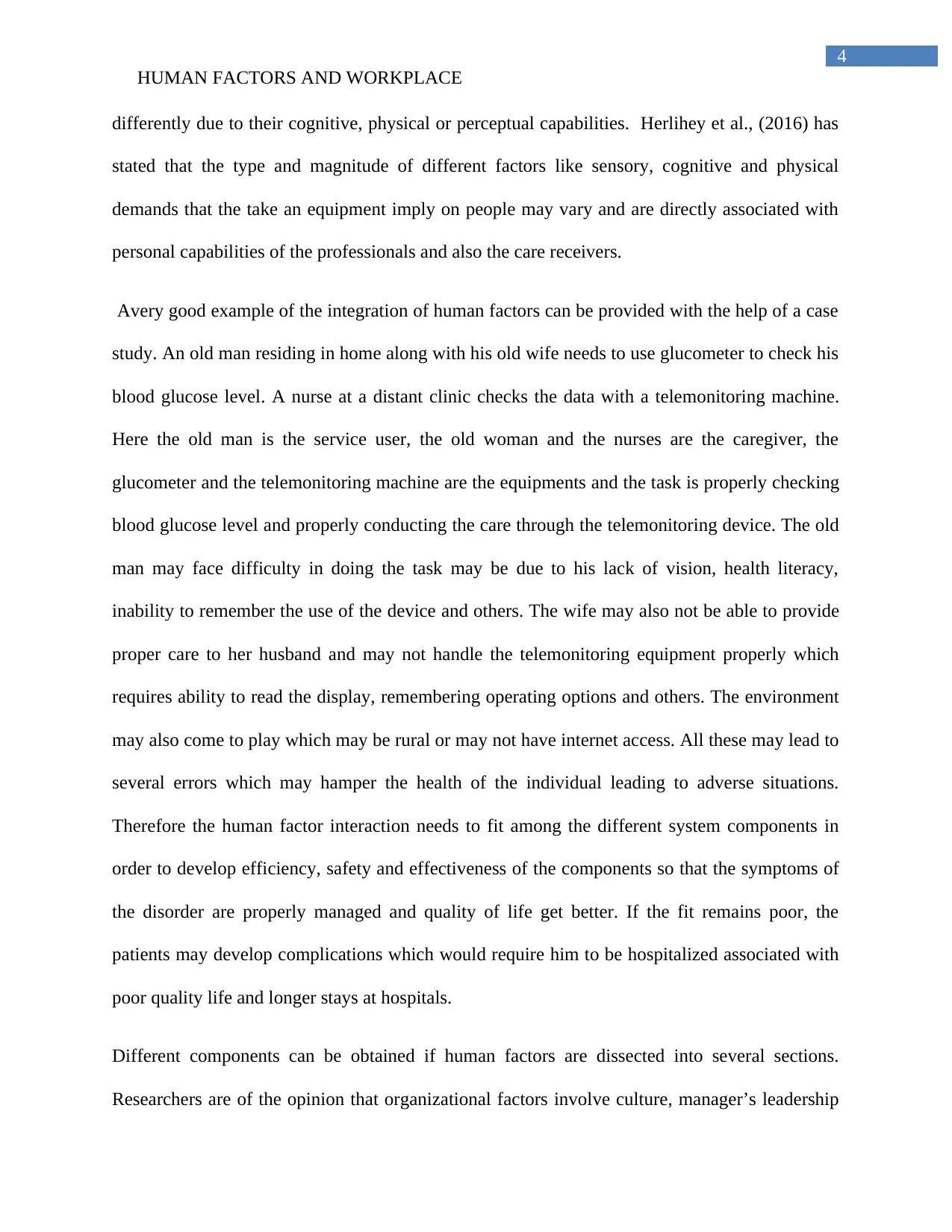
4
HUMAN FACTORS AND WORKPLACE
differently due to their cognitive, physical or perceptual capabilities. Herlihey et al., (2016) has
stated that the type and magnitude of different factors like sensory, cognitive and physical
demands that the take an equipment imply on people may vary and are directly associated with
personal capabilities of the professionals and also the care receivers.
Avery good example of the integration of human factors can be provided with the help of a case
study. An old man residing in home along with his old wife needs to use glucometer to check his
blood glucose level. A nurse at a distant clinic checks the data with a telemonitoring machine.
Here the old man is the service user, the old woman and the nurses are the caregiver, the
glucometer and the telemonitoring machine are the equipments and the task is properly checking
blood glucose level and properly conducting the care through the telemonitoring device. The old
man may face difficulty in doing the task may be due to his lack of vision, health literacy,
inability to remember the use of the device and others. The wife may also not be able to provide
proper care to her husband and may not handle the telemonitoring equipment properly which
requires ability to read the display, remembering operating options and others. The environment
may also come to play which may be rural or may not have internet access. All these may lead to
several errors which may hamper the health of the individual leading to adverse situations.
Therefore the human factor interaction needs to fit among the different system components in
order to develop efficiency, safety and effectiveness of the components so that the symptoms of
the disorder are properly managed and quality of life get better. If the fit remains poor, the
patients may develop complications which would require him to be hospitalized associated with
poor quality life and longer stays at hospitals.
Different components can be obtained if human factors are dissected into several sections.
Researchers are of the opinion that organizational factors involve culture, manager’s leadership
HUMAN FACTORS AND WORKPLACE
differently due to their cognitive, physical or perceptual capabilities. Herlihey et al., (2016) has
stated that the type and magnitude of different factors like sensory, cognitive and physical
demands that the take an equipment imply on people may vary and are directly associated with
personal capabilities of the professionals and also the care receivers.
Avery good example of the integration of human factors can be provided with the help of a case
study. An old man residing in home along with his old wife needs to use glucometer to check his
blood glucose level. A nurse at a distant clinic checks the data with a telemonitoring machine.
Here the old man is the service user, the old woman and the nurses are the caregiver, the
glucometer and the telemonitoring machine are the equipments and the task is properly checking
blood glucose level and properly conducting the care through the telemonitoring device. The old
man may face difficulty in doing the task may be due to his lack of vision, health literacy,
inability to remember the use of the device and others. The wife may also not be able to provide
proper care to her husband and may not handle the telemonitoring equipment properly which
requires ability to read the display, remembering operating options and others. The environment
may also come to play which may be rural or may not have internet access. All these may lead to
several errors which may hamper the health of the individual leading to adverse situations.
Therefore the human factor interaction needs to fit among the different system components in
order to develop efficiency, safety and effectiveness of the components so that the symptoms of
the disorder are properly managed and quality of life get better. If the fit remains poor, the
patients may develop complications which would require him to be hospitalized associated with
poor quality life and longer stays at hospitals.
Different components can be obtained if human factors are dissected into several sections.
Researchers are of the opinion that organizational factors involve culture, manager’s leadership
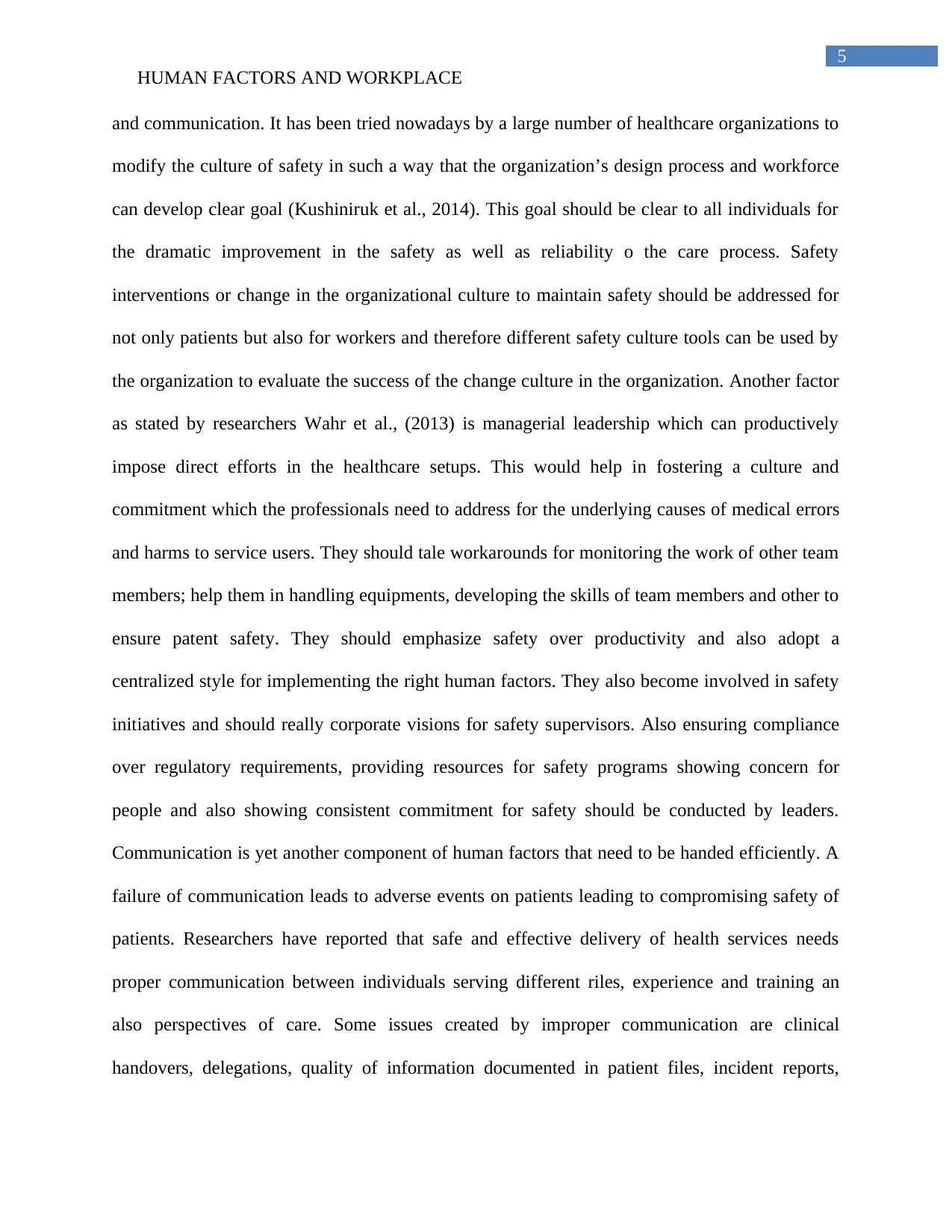
5
HUMAN FACTORS AND WORKPLACE
and communication. It has been tried nowadays by a large number of healthcare organizations to
modify the culture of safety in such a way that the organization’s design process and workforce
can develop clear goal (Kushiniruk et al., 2014). This goal should be clear to all individuals for
the dramatic improvement in the safety as well as reliability o the care process. Safety
interventions or change in the organizational culture to maintain safety should be addressed for
not only patients but also for workers and therefore different safety culture tools can be used by
the organization to evaluate the success of the change culture in the organization. Another factor
as stated by researchers Wahr et al., (2013) is managerial leadership which can productively
impose direct efforts in the healthcare setups. This would help in fostering a culture and
commitment which the professionals need to address for the underlying causes of medical errors
and harms to service users. They should tale workarounds for monitoring the work of other team
members; help them in handling equipments, developing the skills of team members and other to
ensure patent safety. They should emphasize safety over productivity and also adopt a
centralized style for implementing the right human factors. They also become involved in safety
initiatives and should really corporate visions for safety supervisors. Also ensuring compliance
over regulatory requirements, providing resources for safety programs showing concern for
people and also showing consistent commitment for safety should be conducted by leaders.
Communication is yet another component of human factors that need to be handed efficiently. A
failure of communication leads to adverse events on patients leading to compromising safety of
patients. Researchers have reported that safe and effective delivery of health services needs
proper communication between individuals serving different riles, experience and training an
also perspectives of care. Some issues created by improper communication are clinical
handovers, delegations, quality of information documented in patient files, incident reports,
HUMAN FACTORS AND WORKPLACE
and communication. It has been tried nowadays by a large number of healthcare organizations to
modify the culture of safety in such a way that the organization’s design process and workforce
can develop clear goal (Kushiniruk et al., 2014). This goal should be clear to all individuals for
the dramatic improvement in the safety as well as reliability o the care process. Safety
interventions or change in the organizational culture to maintain safety should be addressed for
not only patients but also for workers and therefore different safety culture tools can be used by
the organization to evaluate the success of the change culture in the organization. Another factor
as stated by researchers Wahr et al., (2013) is managerial leadership which can productively
impose direct efforts in the healthcare setups. This would help in fostering a culture and
commitment which the professionals need to address for the underlying causes of medical errors
and harms to service users. They should tale workarounds for monitoring the work of other team
members; help them in handling equipments, developing the skills of team members and other to
ensure patent safety. They should emphasize safety over productivity and also adopt a
centralized style for implementing the right human factors. They also become involved in safety
initiatives and should really corporate visions for safety supervisors. Also ensuring compliance
over regulatory requirements, providing resources for safety programs showing concern for
people and also showing consistent commitment for safety should be conducted by leaders.
Communication is yet another component of human factors that need to be handed efficiently. A
failure of communication leads to adverse events on patients leading to compromising safety of
patients. Researchers have reported that safe and effective delivery of health services needs
proper communication between individuals serving different riles, experience and training an
also perspectives of care. Some issues created by improper communication are clinical
handovers, delegations, quality of information documented in patient files, incident reports,
⊘ This is a preview!⊘
Do you want full access?
Subscribe today to unlock all pages.

Trusted by 1+ million students worldwide
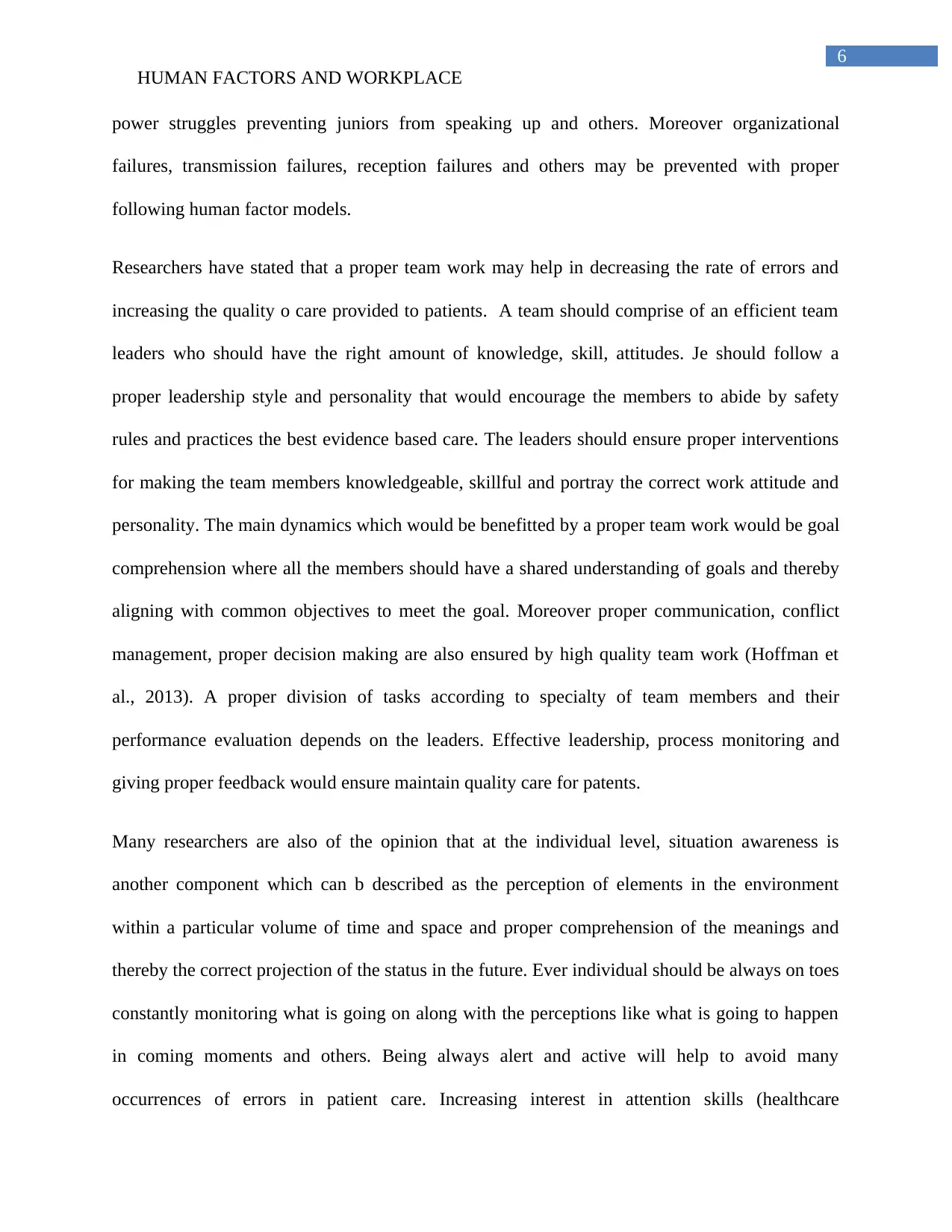
6
HUMAN FACTORS AND WORKPLACE
power struggles preventing juniors from speaking up and others. Moreover organizational
failures, transmission failures, reception failures and others may be prevented with proper
following human factor models.
Researchers have stated that a proper team work may help in decreasing the rate of errors and
increasing the quality o care provided to patients. A team should comprise of an efficient team
leaders who should have the right amount of knowledge, skill, attitudes. Je should follow a
proper leadership style and personality that would encourage the members to abide by safety
rules and practices the best evidence based care. The leaders should ensure proper interventions
for making the team members knowledgeable, skillful and portray the correct work attitude and
personality. The main dynamics which would be benefitted by a proper team work would be goal
comprehension where all the members should have a shared understanding of goals and thereby
aligning with common objectives to meet the goal. Moreover proper communication, conflict
management, proper decision making are also ensured by high quality team work (Hoffman et
al., 2013). A proper division of tasks according to specialty of team members and their
performance evaluation depends on the leaders. Effective leadership, process monitoring and
giving proper feedback would ensure maintain quality care for patents.
Many researchers are also of the opinion that at the individual level, situation awareness is
another component which can b described as the perception of elements in the environment
within a particular volume of time and space and proper comprehension of the meanings and
thereby the correct projection of the status in the future. Ever individual should be always on toes
constantly monitoring what is going on along with the perceptions like what is going to happen
in coming moments and others. Being always alert and active will help to avoid many
occurrences of errors in patient care. Increasing interest in attention skills (healthcare
HUMAN FACTORS AND WORKPLACE
power struggles preventing juniors from speaking up and others. Moreover organizational
failures, transmission failures, reception failures and others may be prevented with proper
following human factor models.
Researchers have stated that a proper team work may help in decreasing the rate of errors and
increasing the quality o care provided to patients. A team should comprise of an efficient team
leaders who should have the right amount of knowledge, skill, attitudes. Je should follow a
proper leadership style and personality that would encourage the members to abide by safety
rules and practices the best evidence based care. The leaders should ensure proper interventions
for making the team members knowledgeable, skillful and portray the correct work attitude and
personality. The main dynamics which would be benefitted by a proper team work would be goal
comprehension where all the members should have a shared understanding of goals and thereby
aligning with common objectives to meet the goal. Moreover proper communication, conflict
management, proper decision making are also ensured by high quality team work (Hoffman et
al., 2013). A proper division of tasks according to specialty of team members and their
performance evaluation depends on the leaders. Effective leadership, process monitoring and
giving proper feedback would ensure maintain quality care for patents.
Many researchers are also of the opinion that at the individual level, situation awareness is
another component which can b described as the perception of elements in the environment
within a particular volume of time and space and proper comprehension of the meanings and
thereby the correct projection of the status in the future. Ever individual should be always on toes
constantly monitoring what is going on along with the perceptions like what is going to happen
in coming moments and others. Being always alert and active will help to avoid many
occurrences of errors in patient care. Increasing interest in attention skills (healthcare
Paraphrase This Document
Need a fresh take? Get an instant paraphrase of this document with our AI Paraphraser
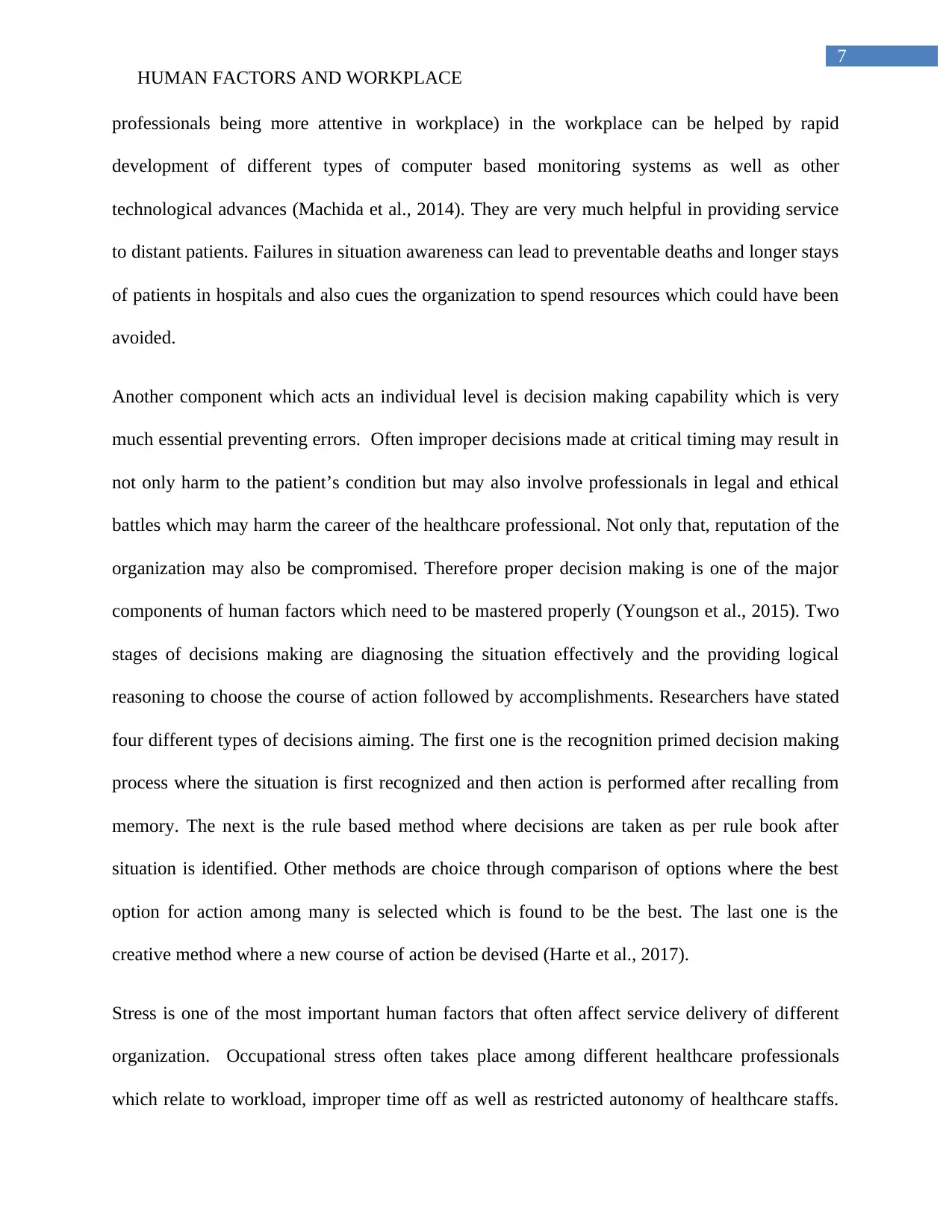
7
HUMAN FACTORS AND WORKPLACE
professionals being more attentive in workplace) in the workplace can be helped by rapid
development of different types of computer based monitoring systems as well as other
technological advances (Machida et al., 2014). They are very much helpful in providing service
to distant patients. Failures in situation awareness can lead to preventable deaths and longer stays
of patients in hospitals and also cues the organization to spend resources which could have been
avoided.
Another component which acts an individual level is decision making capability which is very
much essential preventing errors. Often improper decisions made at critical timing may result in
not only harm to the patient’s condition but may also involve professionals in legal and ethical
battles which may harm the career of the healthcare professional. Not only that, reputation of the
organization may also be compromised. Therefore proper decision making is one of the major
components of human factors which need to be mastered properly (Youngson et al., 2015). Two
stages of decisions making are diagnosing the situation effectively and the providing logical
reasoning to choose the course of action followed by accomplishments. Researchers have stated
four different types of decisions aiming. The first one is the recognition primed decision making
process where the situation is first recognized and then action is performed after recalling from
memory. The next is the rule based method where decisions are taken as per rule book after
situation is identified. Other methods are choice through comparison of options where the best
option for action among many is selected which is found to be the best. The last one is the
creative method where a new course of action be devised (Harte et al., 2017).
Stress is one of the most important human factors that often affect service delivery of different
organization. Occupational stress often takes place among different healthcare professionals
which relate to workload, improper time off as well as restricted autonomy of healthcare staffs.
HUMAN FACTORS AND WORKPLACE
professionals being more attentive in workplace) in the workplace can be helped by rapid
development of different types of computer based monitoring systems as well as other
technological advances (Machida et al., 2014). They are very much helpful in providing service
to distant patients. Failures in situation awareness can lead to preventable deaths and longer stays
of patients in hospitals and also cues the organization to spend resources which could have been
avoided.
Another component which acts an individual level is decision making capability which is very
much essential preventing errors. Often improper decisions made at critical timing may result in
not only harm to the patient’s condition but may also involve professionals in legal and ethical
battles which may harm the career of the healthcare professional. Not only that, reputation of the
organization may also be compromised. Therefore proper decision making is one of the major
components of human factors which need to be mastered properly (Youngson et al., 2015). Two
stages of decisions making are diagnosing the situation effectively and the providing logical
reasoning to choose the course of action followed by accomplishments. Researchers have stated
four different types of decisions aiming. The first one is the recognition primed decision making
process where the situation is first recognized and then action is performed after recalling from
memory. The next is the rule based method where decisions are taken as per rule book after
situation is identified. Other methods are choice through comparison of options where the best
option for action among many is selected which is found to be the best. The last one is the
creative method where a new course of action be devised (Harte et al., 2017).
Stress is one of the most important human factors that often affect service delivery of different
organization. Occupational stress often takes place among different healthcare professionals
which relate to workload, improper time off as well as restricted autonomy of healthcare staffs.
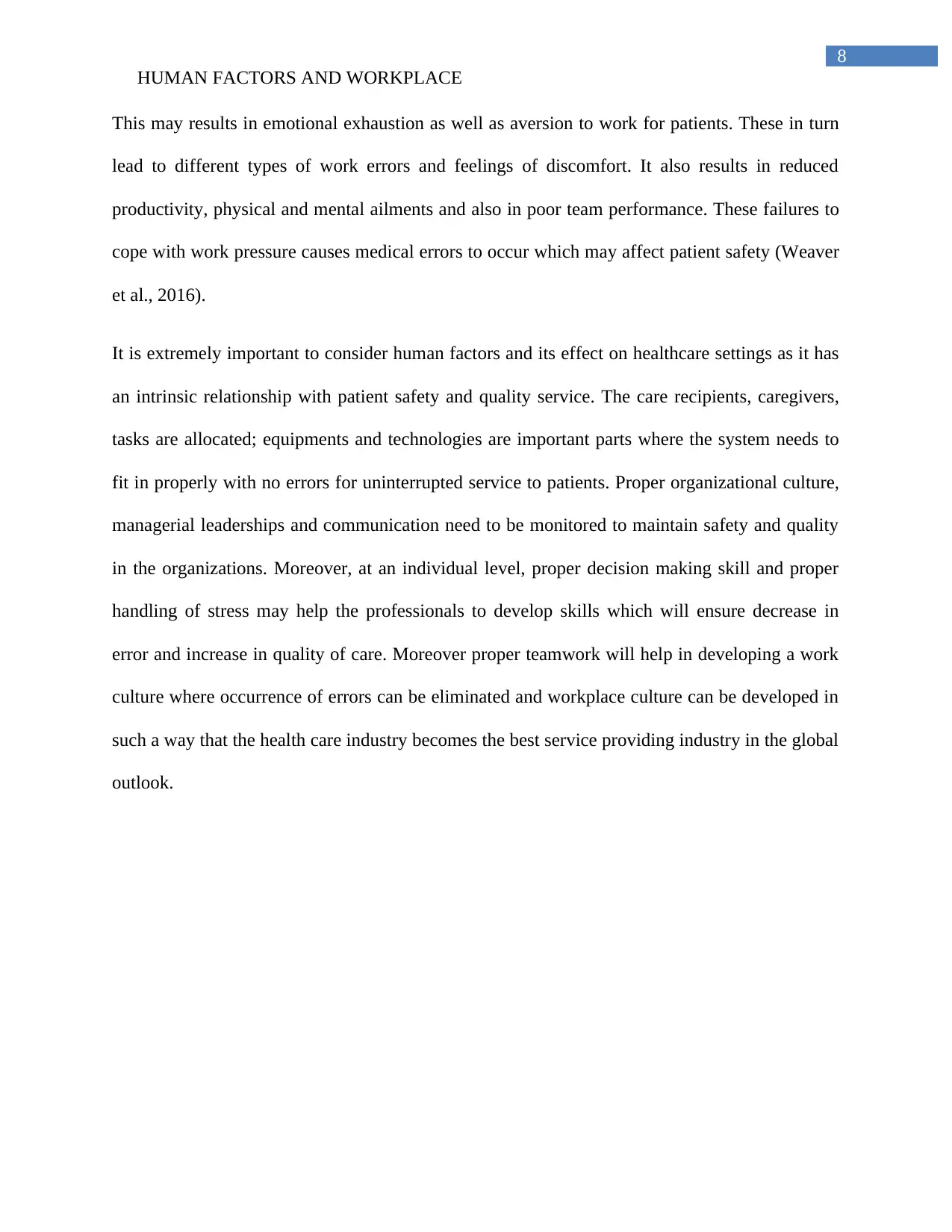
8
HUMAN FACTORS AND WORKPLACE
This may results in emotional exhaustion as well as aversion to work for patients. These in turn
lead to different types of work errors and feelings of discomfort. It also results in reduced
productivity, physical and mental ailments and also in poor team performance. These failures to
cope with work pressure causes medical errors to occur which may affect patient safety (Weaver
et al., 2016).
It is extremely important to consider human factors and its effect on healthcare settings as it has
an intrinsic relationship with patient safety and quality service. The care recipients, caregivers,
tasks are allocated; equipments and technologies are important parts where the system needs to
fit in properly with no errors for uninterrupted service to patients. Proper organizational culture,
managerial leaderships and communication need to be monitored to maintain safety and quality
in the organizations. Moreover, at an individual level, proper decision making skill and proper
handling of stress may help the professionals to develop skills which will ensure decrease in
error and increase in quality of care. Moreover proper teamwork will help in developing a work
culture where occurrence of errors can be eliminated and workplace culture can be developed in
such a way that the health care industry becomes the best service providing industry in the global
outlook.
HUMAN FACTORS AND WORKPLACE
This may results in emotional exhaustion as well as aversion to work for patients. These in turn
lead to different types of work errors and feelings of discomfort. It also results in reduced
productivity, physical and mental ailments and also in poor team performance. These failures to
cope with work pressure causes medical errors to occur which may affect patient safety (Weaver
et al., 2016).
It is extremely important to consider human factors and its effect on healthcare settings as it has
an intrinsic relationship with patient safety and quality service. The care recipients, caregivers,
tasks are allocated; equipments and technologies are important parts where the system needs to
fit in properly with no errors for uninterrupted service to patients. Proper organizational culture,
managerial leaderships and communication need to be monitored to maintain safety and quality
in the organizations. Moreover, at an individual level, proper decision making skill and proper
handling of stress may help the professionals to develop skills which will ensure decrease in
error and increase in quality of care. Moreover proper teamwork will help in developing a work
culture where occurrence of errors can be eliminated and workplace culture can be developed in
such a way that the health care industry becomes the best service providing industry in the global
outlook.
⊘ This is a preview!⊘
Do you want full access?
Subscribe today to unlock all pages.

Trusted by 1+ million students worldwide
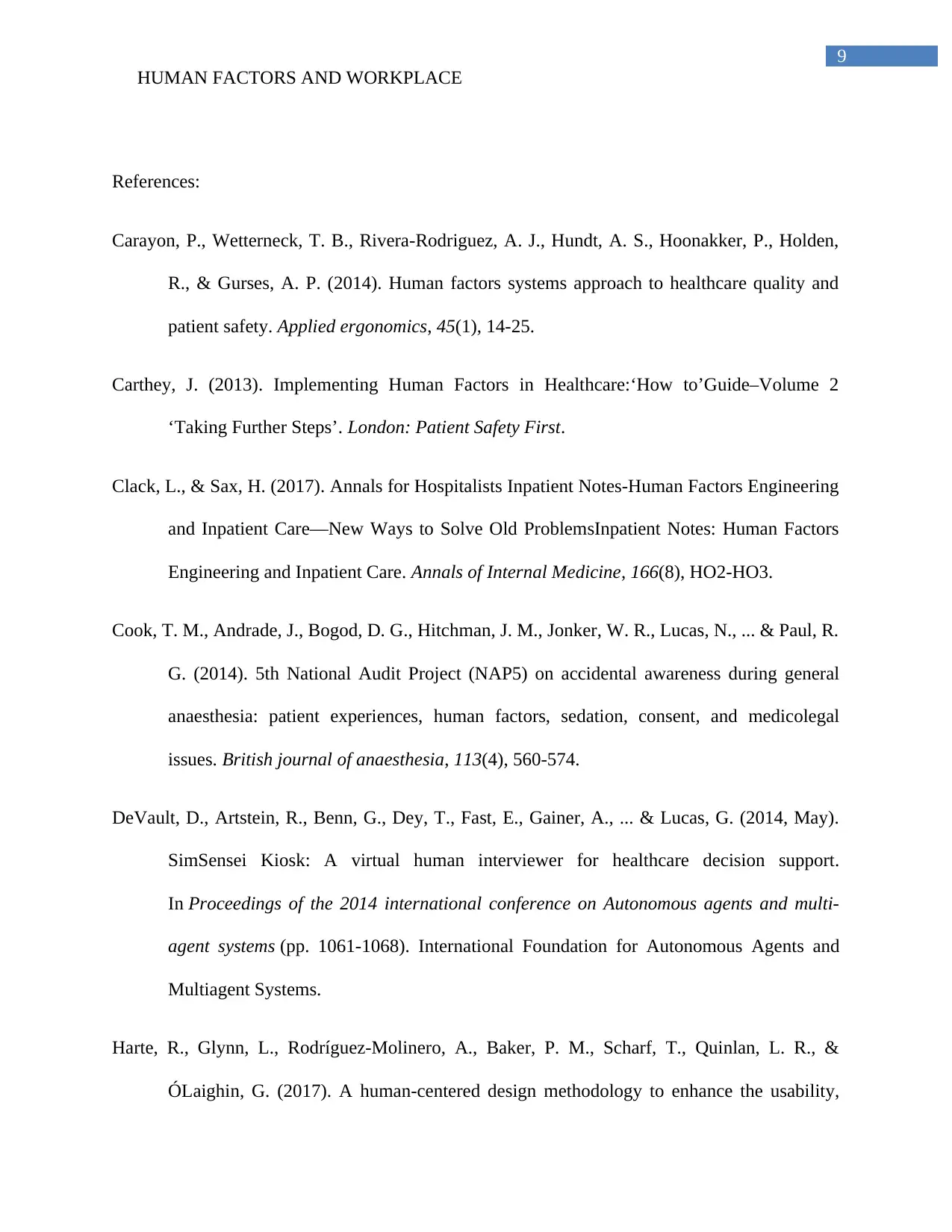
9
HUMAN FACTORS AND WORKPLACE
References:
Carayon, P., Wetterneck, T. B., Rivera-Rodriguez, A. J., Hundt, A. S., Hoonakker, P., Holden,
R., & Gurses, A. P. (2014). Human factors systems approach to healthcare quality and
patient safety. Applied ergonomics, 45(1), 14-25.
Carthey, J. (2013). Implementing Human Factors in Healthcare:‘How to’Guide–Volume 2
‘Taking Further Steps’. London: Patient Safety First.
Clack, L., & Sax, H. (2017). Annals for Hospitalists Inpatient Notes-Human Factors Engineering
and Inpatient Care—New Ways to Solve Old ProblemsInpatient Notes: Human Factors
Engineering and Inpatient Care. Annals of Internal Medicine, 166(8), HO2-HO3.
Cook, T. M., Andrade, J., Bogod, D. G., Hitchman, J. M., Jonker, W. R., Lucas, N., ... & Paul, R.
G. (2014). 5th National Audit Project (NAP5) on accidental awareness during general
anaesthesia: patient experiences, human factors, sedation, consent, and medicolegal
issues. British journal of anaesthesia, 113(4), 560-574.
DeVault, D., Artstein, R., Benn, G., Dey, T., Fast, E., Gainer, A., ... & Lucas, G. (2014, May).
SimSensei Kiosk: A virtual human interviewer for healthcare decision support.
In Proceedings of the 2014 international conference on Autonomous agents and multi-
agent systems (pp. 1061-1068). International Foundation for Autonomous Agents and
Multiagent Systems.
Harte, R., Glynn, L., Rodríguez-Molinero, A., Baker, P. M., Scharf, T., Quinlan, L. R., &
ÓLaighin, G. (2017). A human-centered design methodology to enhance the usability,
HUMAN FACTORS AND WORKPLACE
References:
Carayon, P., Wetterneck, T. B., Rivera-Rodriguez, A. J., Hundt, A. S., Hoonakker, P., Holden,
R., & Gurses, A. P. (2014). Human factors systems approach to healthcare quality and
patient safety. Applied ergonomics, 45(1), 14-25.
Carthey, J. (2013). Implementing Human Factors in Healthcare:‘How to’Guide–Volume 2
‘Taking Further Steps’. London: Patient Safety First.
Clack, L., & Sax, H. (2017). Annals for Hospitalists Inpatient Notes-Human Factors Engineering
and Inpatient Care—New Ways to Solve Old ProblemsInpatient Notes: Human Factors
Engineering and Inpatient Care. Annals of Internal Medicine, 166(8), HO2-HO3.
Cook, T. M., Andrade, J., Bogod, D. G., Hitchman, J. M., Jonker, W. R., Lucas, N., ... & Paul, R.
G. (2014). 5th National Audit Project (NAP5) on accidental awareness during general
anaesthesia: patient experiences, human factors, sedation, consent, and medicolegal
issues. British journal of anaesthesia, 113(4), 560-574.
DeVault, D., Artstein, R., Benn, G., Dey, T., Fast, E., Gainer, A., ... & Lucas, G. (2014, May).
SimSensei Kiosk: A virtual human interviewer for healthcare decision support.
In Proceedings of the 2014 international conference on Autonomous agents and multi-
agent systems (pp. 1061-1068). International Foundation for Autonomous Agents and
Multiagent Systems.
Harte, R., Glynn, L., Rodríguez-Molinero, A., Baker, P. M., Scharf, T., Quinlan, L. R., &
ÓLaighin, G. (2017). A human-centered design methodology to enhance the usability,
Paraphrase This Document
Need a fresh take? Get an instant paraphrase of this document with our AI Paraphraser
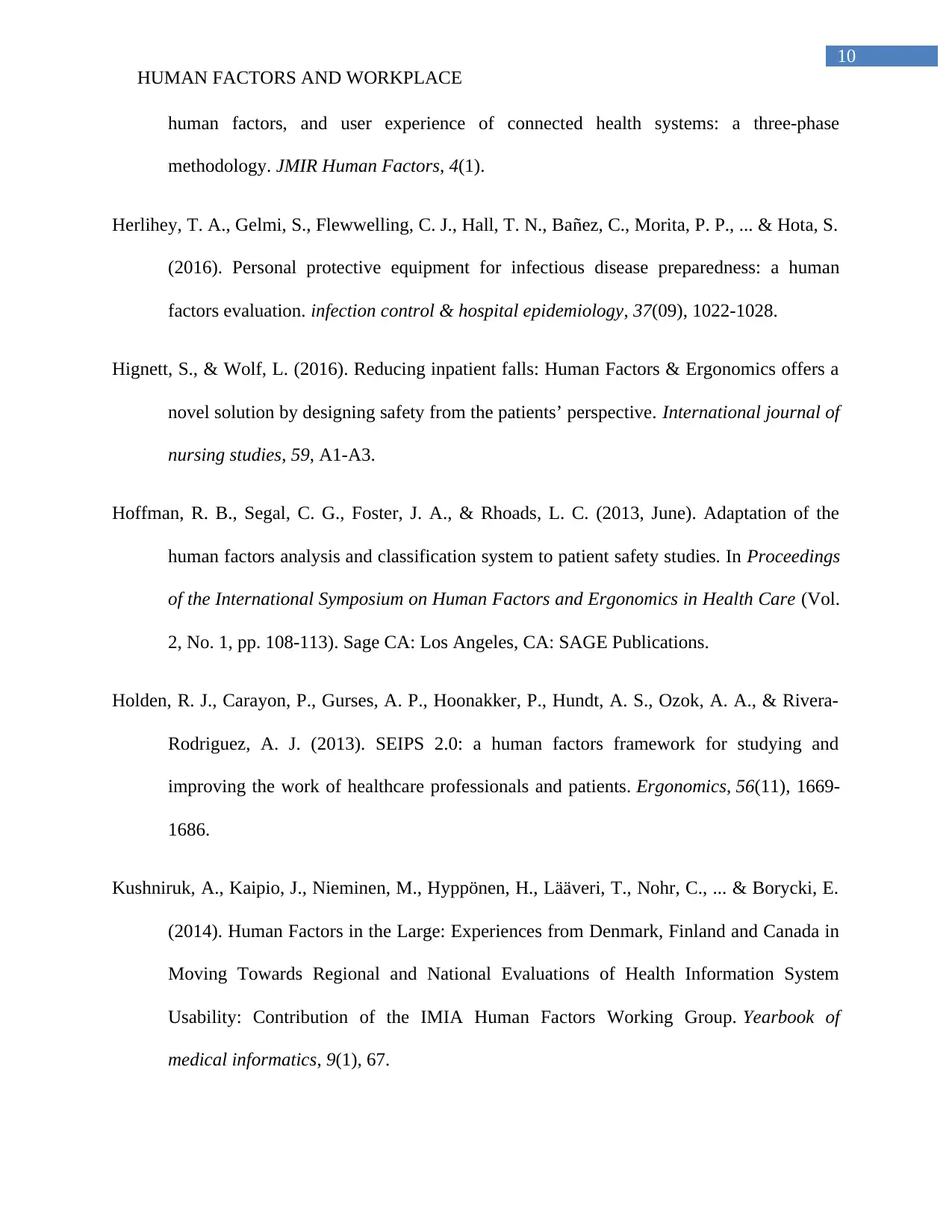
10
HUMAN FACTORS AND WORKPLACE
human factors, and user experience of connected health systems: a three-phase
methodology. JMIR Human Factors, 4(1).
Herlihey, T. A., Gelmi, S., Flewwelling, C. J., Hall, T. N., Bañez, C., Morita, P. P., ... & Hota, S.
(2016). Personal protective equipment for infectious disease preparedness: a human
factors evaluation. infection control & hospital epidemiology, 37(09), 1022-1028.
Hignett, S., & Wolf, L. (2016). Reducing inpatient falls: Human Factors & Ergonomics offers a
novel solution by designing safety from the patients’ perspective. International journal of
nursing studies, 59, A1-A3.
Hoffman, R. B., Segal, C. G., Foster, J. A., & Rhoads, L. C. (2013, June). Adaptation of the
human factors analysis and classification system to patient safety studies. In Proceedings
of the International Symposium on Human Factors and Ergonomics in Health Care (Vol.
2, No. 1, pp. 108-113). Sage CA: Los Angeles, CA: SAGE Publications.
Holden, R. J., Carayon, P., Gurses, A. P., Hoonakker, P., Hundt, A. S., Ozok, A. A., & Rivera-
Rodriguez, A. J. (2013). SEIPS 2.0: a human factors framework for studying and
improving the work of healthcare professionals and patients. Ergonomics, 56(11), 1669-
1686.
Kushniruk, A., Kaipio, J., Nieminen, M., Hyppönen, H., Lääveri, T., Nohr, C., ... & Borycki, E.
(2014). Human Factors in the Large: Experiences from Denmark, Finland and Canada in
Moving Towards Regional and National Evaluations of Health Information System
Usability: Contribution of the IMIA Human Factors Working Group. Yearbook of
medical informatics, 9(1), 67.
HUMAN FACTORS AND WORKPLACE
human factors, and user experience of connected health systems: a three-phase
methodology. JMIR Human Factors, 4(1).
Herlihey, T. A., Gelmi, S., Flewwelling, C. J., Hall, T. N., Bañez, C., Morita, P. P., ... & Hota, S.
(2016). Personal protective equipment for infectious disease preparedness: a human
factors evaluation. infection control & hospital epidemiology, 37(09), 1022-1028.
Hignett, S., & Wolf, L. (2016). Reducing inpatient falls: Human Factors & Ergonomics offers a
novel solution by designing safety from the patients’ perspective. International journal of
nursing studies, 59, A1-A3.
Hoffman, R. B., Segal, C. G., Foster, J. A., & Rhoads, L. C. (2013, June). Adaptation of the
human factors analysis and classification system to patient safety studies. In Proceedings
of the International Symposium on Human Factors and Ergonomics in Health Care (Vol.
2, No. 1, pp. 108-113). Sage CA: Los Angeles, CA: SAGE Publications.
Holden, R. J., Carayon, P., Gurses, A. P., Hoonakker, P., Hundt, A. S., Ozok, A. A., & Rivera-
Rodriguez, A. J. (2013). SEIPS 2.0: a human factors framework for studying and
improving the work of healthcare professionals and patients. Ergonomics, 56(11), 1669-
1686.
Kushniruk, A., Kaipio, J., Nieminen, M., Hyppönen, H., Lääveri, T., Nohr, C., ... & Borycki, E.
(2014). Human Factors in the Large: Experiences from Denmark, Finland and Canada in
Moving Towards Regional and National Evaluations of Health Information System
Usability: Contribution of the IMIA Human Factors Working Group. Yearbook of
medical informatics, 9(1), 67.
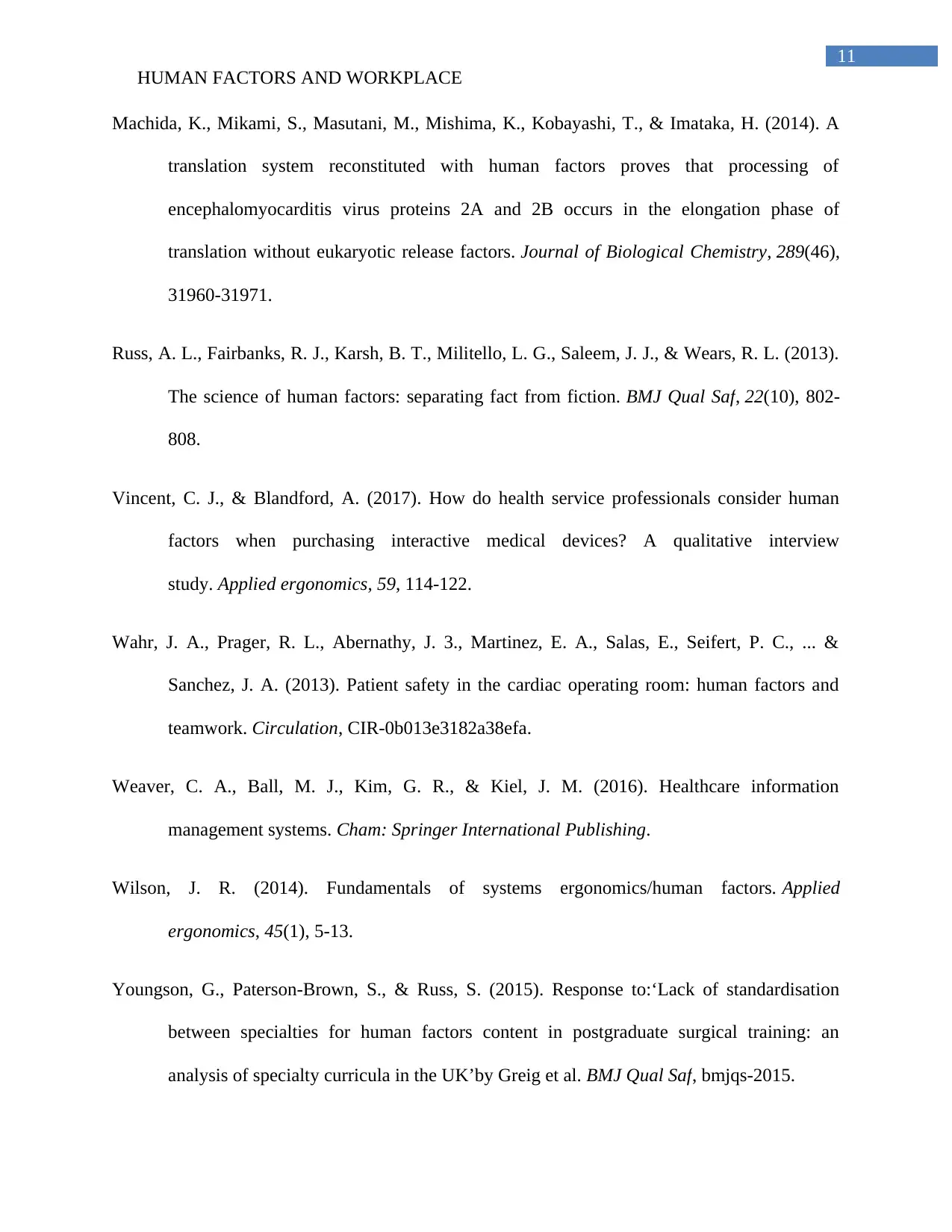
11
HUMAN FACTORS AND WORKPLACE
Machida, K., Mikami, S., Masutani, M., Mishima, K., Kobayashi, T., & Imataka, H. (2014). A
translation system reconstituted with human factors proves that processing of
encephalomyocarditis virus proteins 2A and 2B occurs in the elongation phase of
translation without eukaryotic release factors. Journal of Biological Chemistry, 289(46),
31960-31971.
Russ, A. L., Fairbanks, R. J., Karsh, B. T., Militello, L. G., Saleem, J. J., & Wears, R. L. (2013).
The science of human factors: separating fact from fiction. BMJ Qual Saf, 22(10), 802-
808.
Vincent, C. J., & Blandford, A. (2017). How do health service professionals consider human
factors when purchasing interactive medical devices? A qualitative interview
study. Applied ergonomics, 59, 114-122.
Wahr, J. A., Prager, R. L., Abernathy, J. 3., Martinez, E. A., Salas, E., Seifert, P. C., ... &
Sanchez, J. A. (2013). Patient safety in the cardiac operating room: human factors and
teamwork. Circulation, CIR-0b013e3182a38efa.
Weaver, C. A., Ball, M. J., Kim, G. R., & Kiel, J. M. (2016). Healthcare information
management systems. Cham: Springer International Publishing.
Wilson, J. R. (2014). Fundamentals of systems ergonomics/human factors. Applied
ergonomics, 45(1), 5-13.
Youngson, G., Paterson-Brown, S., & Russ, S. (2015). Response to:‘Lack of standardisation
between specialties for human factors content in postgraduate surgical training: an
analysis of specialty curricula in the UK’by Greig et al. BMJ Qual Saf, bmjqs-2015.
HUMAN FACTORS AND WORKPLACE
Machida, K., Mikami, S., Masutani, M., Mishima, K., Kobayashi, T., & Imataka, H. (2014). A
translation system reconstituted with human factors proves that processing of
encephalomyocarditis virus proteins 2A and 2B occurs in the elongation phase of
translation without eukaryotic release factors. Journal of Biological Chemistry, 289(46),
31960-31971.
Russ, A. L., Fairbanks, R. J., Karsh, B. T., Militello, L. G., Saleem, J. J., & Wears, R. L. (2013).
The science of human factors: separating fact from fiction. BMJ Qual Saf, 22(10), 802-
808.
Vincent, C. J., & Blandford, A. (2017). How do health service professionals consider human
factors when purchasing interactive medical devices? A qualitative interview
study. Applied ergonomics, 59, 114-122.
Wahr, J. A., Prager, R. L., Abernathy, J. 3., Martinez, E. A., Salas, E., Seifert, P. C., ... &
Sanchez, J. A. (2013). Patient safety in the cardiac operating room: human factors and
teamwork. Circulation, CIR-0b013e3182a38efa.
Weaver, C. A., Ball, M. J., Kim, G. R., & Kiel, J. M. (2016). Healthcare information
management systems. Cham: Springer International Publishing.
Wilson, J. R. (2014). Fundamentals of systems ergonomics/human factors. Applied
ergonomics, 45(1), 5-13.
Youngson, G., Paterson-Brown, S., & Russ, S. (2015). Response to:‘Lack of standardisation
between specialties for human factors content in postgraduate surgical training: an
analysis of specialty curricula in the UK’by Greig et al. BMJ Qual Saf, bmjqs-2015.
⊘ This is a preview!⊘
Do you want full access?
Subscribe today to unlock all pages.

Trusted by 1+ million students worldwide
1 out of 13
Related Documents
Your All-in-One AI-Powered Toolkit for Academic Success.
+13062052269
info@desklib.com
Available 24*7 on WhatsApp / Email
![[object Object]](/_next/static/media/star-bottom.7253800d.svg)
Unlock your academic potential
Copyright © 2020–2025 A2Z Services. All Rights Reserved. Developed and managed by ZUCOL.





